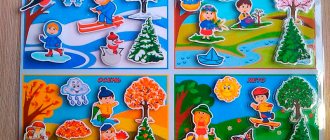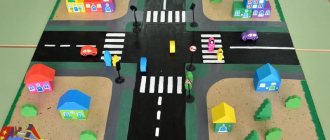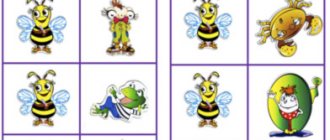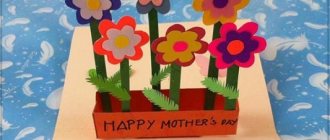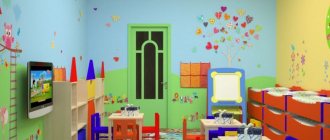What teaching aids can you make yourself for kindergarten?
Language development is not an isolated skill. To a large extent, it is determined by the general level of development of the child and, in particular, his intelligence.
Didactic manual on speech development
Activities that improve sensory and fine motor skills in children are of great importance in this process. For this, it is important to use teaching aids, a significant part of which can be made independently.
Children's learning, especially in junior and middle groups, should take place in a playful environment, otherwise they will lose interest in the subject and time will be wasted. For teaching to be effective, the teacher needs to use all available means to maintain the child’s useful activity.
Didactic materials for sensory development
The “Flower Petals” manual looks like this. A circle is attached perpendicularly to the straight stem. The edges of the central part are covered with Velcro. Several petals with images of objects or fairy-tale characters are offered. This fabric is also attached to the inner edge of each of them. The task is to find the petals with the corresponding words based on the letter drawn on the mug and attach them to the central part.
The game “Blow out the insects into the clearing” is designed to develop speech breathing. For this purpose, the “Polyanka” manual is used. It is a low box with high sides. Small cardboards with images of animals are suspended on short threads from the outside. The child must blow them out, but does not have the right to puff out his cheeks.
Important! In this way he is taught how to breathe correctly during a conversation.
The game "Clothespins" is made using the same manual. For this, the kids are given several colored clothespins and asked to build a fence. They place them on the edges, while loudly calling out the color used.
There are two horizontal lines of Velcro glued to the outer wall of the Polyanka manual. Each row contains four cards with images of animals, fairy-tale characters or objects. The child is told that in each row one of the pictures is extra and is asked to remove it. Then he should tell what the remaining images have in common and why.
Lesson with children
Iconic didactic materials
One of these multifunctional aids is “Teremok”. It is a fabric house attached to a flat, solid base. It has a large number of pockets sewn into it, in which various pictures are placed. They can depict objects of the surrounding world, fairy-tale characters from the fairy tale of the same name, images of letters or syllables.
Programs for speech development in preschool educational institutions in accordance with the Federal State Educational Standard
There are various ways to use this manual in kindergarten.
Here's one of them. Children are shown pictures taken from a pocket attached to the tower. They ask what fairy tale this hero, who is depicted on the card, came from. The child must remember the name of the fairy tale and try to retell its content.
Important! If the child needs the help of a speech therapist, then it is provided. During the story, the teacher asks the child simple leading questions.
You can also use this manual in a preschool educational institution as follows:
- The teacher takes out cards showing the inhabitants of the tower, but does not show them. He depicts the sounds these animals make. The child must repeat them and name the hero of the fairy tale who is depicted on the card.
- The manual can be used to study prepositions that show the relative position of cards. The teacher places cards with pictures of animals in various pockets and asks questions about who is located where. The child must answer using the prepositions “above,” “under,” or “between.”
- Then the child is asked to formulate questions using the mentioned prepositions and ask them to the teacher.
Another task is the following:
- The child is given cards with images of fairy tale characters and asked to place them in various pockets.
- After this, the kid must say which animal lives on which floor and who is to the left, right, above or below him.
Methodological guide to speech development for children of senior preschool age
Root tops
Purpose of the game
. Exercise children in classifying vegetables (based on the principle: what is edible - the root or the fruit on the stem).
Progress of the game
. The teacher clarifies with the children what they will call “tops” and what “roots.” “We will call the edible root of a vegetable “roots,” and the edible fruit on the stem “tops.” The teacher names a vegetable, and the children quickly answer what is edible in it: the tops or roots. The teacher warns the children to be careful, as some vegetables contain both edibles. The teacher calls: “Carrot!” The children answer: “Roots.” "Tomato!" - “Tops.” "Onion!" - “Tops and roots.”
The teacher may offer another option; he says: “Tops,” and the children remember vegetables whose tops are edible. This game is good to play after a conversation about vegetables, about the garden.
Name three things
Purpose of the game
. Exercise children in classifying objects.
Progress of the game
. “Children,” says the teacher, “we have already played different games where we had to quickly find the right word. Now we will play a similar game, but we will only select not one word, but three at once. I will name one word, for example “furniture”, and the one to whom I throw the ball will name three words that can be called in one word “furniture”. What items can be called in one word “furniture”?” Children: “Table, chair, bed, sofa.” “That’s right,” says the teacher, “but in the game you only need to name three words.” "Flowers!" - says the teacher and after a short pause throws the ball to the child. He answers: “Chamomile, rose, cornflower.”
In this game, children learn to classify three species concepts into one generic concept. In another version of the game, children, on the contrary, learn to find generic concepts using several specific concepts. For example, the teacher calls: “Raspberries, strawberries, currants.” The child who caught the ball answers: “Berries.”
A more complex version of the game will be when the teacher changes the task during one game: either he names specific concepts, and the children find generic ones, or he names generic concepts, and the children indicate specific ones. This option is suggested if children often played various games to classify objects.
This game is recommended to be played with small groups of players.
Hunter
Purpose of the game.
Exercise children in the ability to classify and name animals, fish, birds, etc.
Progress of the game
. Somewhere in a free space at one end of the yard or area there is a group of people playing. This is home. At a distance of several steps from the house - the farther the better - some kind of mark is placed and a line is drawn. This is a forest where different animals live. The hunter, one of the players, goes to this forest. Standing still, he says the following words: “I’m going into the forest to hunt, I will hunt for...” Here he takes a step forward and says: “... a hare”; takes the second step: “...by the bear”; takes the third step: “...like a wolf”; fourth step: “...fox”; fifth: “...a badger...”. With each step the hunter names an animal. You cannot name the same beast twice. You can’t name birds either, but if you play bird hunt, you only need to name birds.
Where are teaching materials used?
The use of hand-made speech development aids for preschoolers creates a playful basis for working with them and determines the storyline of the lesson. A child, especially in the junior and middle groups of kindergarten, thinks concretely, using images, rather than abstract logical constructs. He can react to assignments received from a speech therapist or teacher, being a participant in a specific, albeit fictitious, situation. The teaching aids serve as the factual basis for their learning each year.
Speech development based on visual cues
When a child learns to express his thoughts, he must follow a certain pattern of expressing his thoughts. For a child who is almost unable to concentrate on one subject at his age, this is impossible. Using teaching aids in the form of cue cards helps build a story line. For younger children, we are talking about much simpler things. They simply have to name the objects or briefly describe the actions with the cue cards.
Speech therapist works with a child
For example, in the didactic manual “Zippers,” the child must choose among the open colored zippers lying on the table those that correspond to the teacher’s instructions and close them. At the same time, the child describes his choice, its reasons and the actions he takes.
At an older age, each visual cue can be used together with leading questions from the teacher and be the basis for a coherent story. This can be seen, for example, in classes devoted to professions.
Templates of speech therapy characteristics for children of different levels for PMPC
Every description of your actions, answer to a specific question, or short story based on visual cues helps your child better develop his speech skills. Serve as preparatory exercises for adult life.
Learning to retell
The development of coherent speech in children is one of the most important skills that a child must be taught. Without mastering it, he will not only not be able to develop properly intellectually, but also will not be able to fully socialize, not being able to conduct a dialogue or express his thoughts.
When retelling, the child must create a coherent, long story. However, for this he will need tips, which can be received during didactic games and from the teacher.
The development of fine motor skills plays an important role in this process.
Important! By engaging in retelling, you will be able to strengthen your speech and intellectual skills and increase the level of development of your personality.
Learning to think
Human speech is closely related to thinking. The same is true for a child. Communication is not limited to expressing your thoughts or describing actions. The level of speech proficiency is largely determined by the degree of development of the child’s personality and thinking.
Do-it-yourself teaching aids for kindergarten can be used not only for stories, but also as an excuse to ask your child questions about cause-and-effect relationships in the world around him. For example, using cards related to the plots of fairy tales, you can ask questions about the circumstances of the characters’ actions, the reasons and consequences of their actions.
You can combine the classes in question with the study of mathematics.
In addition, the educational function of speech development classes is important. For example, if a child is asked questions about the features and beneficial properties of the plants depicted in the pictures, then gradually this knowledge will be consolidated in the child. If additional questions are asked about this material, the child’s knowledge will become more detailed and practical.
Preparing for literacy
To do this, you need to learn not only oral speech, but also study letters and words. Children of senior preschool age, with the help of a teacher and parents, are able to master the alphabet and basic reading skills.
For this purpose, a do-it-yourself didactic manual on speech development for kindergarten with cards depicting letters, syllables or words can be used.
Picture 4 Speech corner
A child’s speech needs to be developed from a very early age. This is the only way to ensure that the baby is already talking by the time he goes to school. And he had good diction.
The most effective way to teach a child to speak correctly is to regularly teach him using specialized books. We present a number of works that will help develop a child’s speech.
Speech development for preschoolers. Writer: Svetlova I. E.
With the help of this book you can develop your child's speech and also teach him to speak with expression. Also, the baby will learn to construct sentences and phrases correctly.
The publication will help you prepare your child for school. In the future, with the help of the knowledge acquired in childhood, it will be easier for him to learn.
How well a child’s speech is developed indicates the level of his intelligence. If he speaks beautifully, then this indicates his high level of training. Therefore, special attention should be paid to studies in this area.
We recommend using this book when studying. You can study it with your child. And at the same time, it will be interesting for him to gain new knowledge together with his mother.
The pages of the book present a number of paragraphs that are aimed at different aspects of learning.
In one of them the child will be told about sounds. In another - about letters. The third is about how to put it all into words. And in the fourth - into a sentence.
Also, with the help of this book, the child will be able to increase his vocabulary. He will learn many important words that he will need during his junior year.
The book will teach your child to correctly formulate and voice his thoughts.
Also, the publication presents a number of tasks. They are very interesting and unusual.
The tasks are presented in a playful way, so your child will be able to learn not only effectively, but also have fun.
If you have several children, you can study with them at the same time. All participants in the home “lesson” will be interested in participating in it.
Finger gymnastics for the development of speech in preschoolers. Written by Anishchenkova A.S.
Young children often have problems with speech and the motor system. Some kids are lagging behind in this area. But don't worry, things can be fixed. And A. S. Anishchenkova’s book will help you with this.
With its help, you can correct your child's problems. And also to prevent troubles from arising in the future.
The publication will allow you to intellectually develop your baby. Also, it will help the child while preparing for school.
The basis of training is the development of the hands. As you know, the physical level of development is directly related to speech activity. If it is low, then the child will also be unable to speak well.
To correct the problem, the child will need to move his fingers in a specific sequence. Due to this, he will improve fine motor skills and learn to speak well.
If your child has been diagnosed with a problem with the motor system of the hands, then it needs to be addressed urgently. Buy this book and start doing finger gymnastics with your child.
The work presents a huge number of different tasks and exercises. If you perform them exactly as described in the book, the child will be able to quickly correct the illness. And his fine motor skills will work at an excellent level.
Through exercise, not only your fingers will develop. Your baby's arms and hands will also move well.
In parallel with speech, the child’s memory, logic and thinking will improve. He will become intellectually developed and come to school well prepared.
Not only parents, but also speech therapists can work with children using the method described here. Also, it can be used in kindergartens.
Proverbs for speech development
Proverbs are coherent, rhymed text. They always have a complete thought.
Your task is to recite proverbs with your child until he can pronounce them on his own. Also, the baby must remember them and repeat them. With this, he will be able to understand the meaning described in a certain work.
Proverbs will give the child the opportunity to develop his diction. He will repeat them dozens of times and remember how to pronounce certain words. And what intonations to use for this.
If you want to quickly and effectively develop your child's speech, then this book is for you. We definitely recommend purchasing it.
Speech development. A manual for classes with children from 5 to 6 years old
This publication was created specifically for kindergartens. Teachers use it to teach children to speak and develop their skills.
You can use the book yourself. It is not necessary to resort to the help of third-party specialists. It can be used with children aged five to six years.
The book is written in very simple words. It will not be difficult to understand how to work with your child using it. The authors explain the learning process step by step.
The creators of the book recommend working with your child regularly. At least two to three times a week. At the same time, they recommend reading with your child and teaching him to read and write. If you do not pay enough attention to this point, the child will make mistakes when speaking. And it will sound very bad.
During classes, take breaks and try to use new teaching methods each time. Otherwise, the child will get tired of repeating the same thing over and over again. And if he gets tired of studying, it will be very difficult to regain the desire to gain knowledge.
The classes described in the book are conducted according to a certain structure.
First, the child works on articulation.
Then he moves on to diction. Pronounces tongue twisters mixed with pure tongue twisters.
After this, the child learns grammar. To speak correctly.
In the end, the child will have to learn new words. So that he can express any of his thoughts.
If you wish, you can add here any task or game that you like. The main thing is to make sure that your child has fun during classes.
Additional materials are provided at the end of the book. Also, there you can find answers to some questions that you may have.
We learn poems from pictures. Good memory and diction
Before reaching the age of five, children remember all the information they hear and see. They have automated this process.
However, they cannot set a goal to remember something. They just can't do it.
At the age of six, their memory begins to develop. They can already remember certain information. Moreover, the one they want.
However, children need their parents' help. They should teach them techniques to remember information.
If you do this from childhood, then in the future it will be very easy for the child. He will be able to study at school more easily, and he will not have any problems while studying certain material.
We recommend purchasing this book and studying from it. Here is a rather interesting way of remembering information. We are talking about the so-called “logical correlation”.
The method works like this. The child listens to a certain verse. And it ties specific words to any images.
Let's say the verse mentions a goose. The child must imagine a goose and “attach” a certain text to it.
He must attach a corresponding picture to each line of the work.
When the baby remembers the “attached” images, the text will automatically sound in his head. And the child will be able to remember information more easily.
This is possible due to the fact that his visual and auditory memory are connected together. And now they “help each other.”
The child will be able to apply the method learned through this book in later life. It will be easier for him to remember information. This will be useful at school, university and at work.
Conclusion
Each of these books is good for developing a child’s speech in its own way.
After you purchase a specific publication, start studying with your child regularly. Don't give up on this matter. Otherwise, the child will not be able to learn to speak well.
Always try to keep your classes varied. Introduce game exercises and other elements. Make sure your child doesn't get bored while studying. Otherwise, it will result in a reluctance to gain knowledge in the future.
On the Vikids platform you can:
Read similar articles or write your own.
Go to the Forum.
Find/Buy books.
The importance of didactic material in kindergarten
Didactic manuals serve as the basis for speech development classes. They create a storyline for the lesson, involving children in the game plot. This takes into account the concreteness and figurativeness of children's thinking. With their help, a fascinating game situation is created for the child to learn, where he is passionate and motivated to complete tasks.
The development of children's speech relies heavily on various didactic aids. Their diversity and the ability to make most of them with your own hands allows you to choose a suitable option for conducting classes with children.
